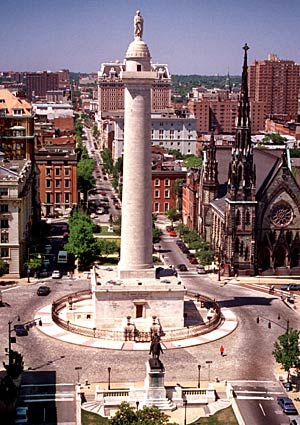Historic Preservation Happenings in Baltimore
 The Washington Monument on Mount Vernon Place, looking north. (Baltimore Sun photo by Amy Davis). May 23, 2001
The Washington Monument on Mount Vernon Place, looking north. (Baltimore Sun photo by Amy Davis). May 23, 2001In "City Council to vote on CHAP merger bill," Baltimore Sun architecture columnist Edward Gunts reports on the legislation to change how the historic preservation board in Baltimore is located within the city government structure. Like DC, they want to move this board to the Planning Office. Currently, it is connected to the Housing Department, although within the last year the staff supporting the CHAP have been moved to the Planning Department
A problem with the legislation isn't this proposed move, but that they propose to change the appeals process, making the Commission on Historic and Architectural Preservation subsidiary to the Planning Commission, which would be able to overturn decisions. Presently, decisions must be appealed to the Baltimore Circuit Court. Hopefully this won't make it into the final legislation. Otherwise, it becomes gutted.
That the Current Newspapers in DC recently suggested in an editorial that the City Council should have the ability to pass-decline Historic Preservation Review Board decisions is similarly worrisome. Philadelphia's Historical Commission has 1/2 of its members being city government officials. Often, political considerations end up shaping the decisions made by the PHC, in ways that can be seriously counter to historic preservation principles and advantages.
Hmm, given the earlier entry of today about intensification of land use following the Inter-County Connector, I'd be "shocked shocked" if the pro-development planning commission would want to "muck up" historic preservation decisions.
In last week's Baltimore news, the City Planning Department proposal to allow 230 feet tall buildings in the Mt. Vernon area of Charles Street was scaled back somewhat by the Planning Commission, to 200 feet tall buildings maximum, but height limits for much of the Mount Vernon remain much lower. (See the letter to the editor "Planning panel protects charm of Mount Vernon.") Also click here for more info on the community's fight against the height increases.
Also see "A walk in Mount Vernon Place: It's among the nation's lovliest urban spaces" by Ed Gunts.



0 Comments:
Post a Comment
<< Home